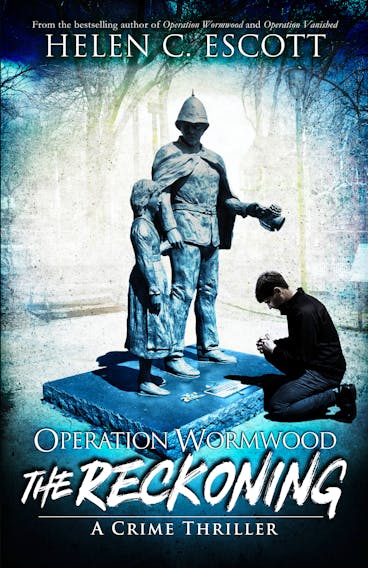Operation Wormwood: The Reckoning
By Helen C. Escott
Flanker Press
$21.95 328 pages
“Operation Wormwood” was a crime novel set in present-day St. John’s, well-paced and authoritative (Escott was a communications strategist with the RCMP), and a finalist for the 2019 Arthur Ellis Awards for Best First Crime Novel.
But it was also somewhat of a disagreeable read, as a series of prominent citizens, linked by sordid and despicable deeds, died under gruesome circumstances.
It wasn’t a book you could necessarily recommend to a mystery enthusiast who would measure, say, Miss Marple setting a teacup into its saucer with a soupcon of sharpness, as to be at daggers drawn.
“Operation Vanished” (2020) was the follow-up, and this new release “Operation Wormwood: The Reckoning” concludes the trilogy.
It opens with a conversation between Father Peter Cooke, who “looked like he fell out of a 1950s-era movie,” and Kathie Fagan, formerly Sister Pius, who at age 50 has left her convent life behind.

The priest himself has just returned from Rome, where he tried to deliver a message, not heeded, about the long-waning influence of religious traditions:
“Weddings take place on sandy beaches. Christmas is about how many gifts you can fit under a tree, and then post pictures of the extravagance on Facebook, so others less fortunate can feel bad about themselves.”
Fagan, in turn, reveals a personal secret that embeds her to events arcing back the first book (I won’t spoil it here). And they discuss the detective pivotal to the investigation that drove that story, Sgt. Nicholas Myra.
His nomenclatural reference to Saint Nicholas, aka Santa Claus, is no accident. But Myra is no jolly fellow.
Though deeply concerned with children, he does not bring them gifts.
“Weddings take place on sandy beaches. Christmas is about how many gifts you can fit under a tree, and then post pictures of the extravagance on Facebook, so others less fortunate can feel bad about themselves.”
Myra is the commander of the Royal Newfoundland Constabulary's integrated child exploitation (ICE) unit.
He’s spent 30 years on the force, and that afternoon had been presented with a chief’s commendation for disrupting and exposing a ring of powerful men who’d preyed on children. He doesn’t care. He doesn’t even tell his staff, nor his family — certainly not his ex-wife, Maria. He isn’t buoyed by his success, but weighed by his failures.
In his line of work, there is always one who gets away. Most notably here is a suspect named Kevin Macy, a disgraced child psychologist. Sitting in his office, watching the sun set over Signal Hill, Myra is haunted, unwell and borderline suicidal.
Then — the sound of a shot. A cry of “Officer down!”
Someone has been attacked just as he left headquarters and got into his patrol car.
This brings Dr. Luke Gillespie into the scene.
Age 35, and overworked, he has an ally at his side, nurse Angela Catania.
Together they administer a very special hospital ward, their work there very much entwined with Myra’s.
But now they are both on the run to emergency:
“Angela’s breath caught in her throat when she spotted the size 12 black boots dangling off the edge of the gurney. Nurses had surrounded the bed, inserting IVs in the victim’s arm and attaching a blood pressure cuff and electrodes. A large, bloodied towel covered the patient’s chest.”
She helps rush him into the operating room where the trauma team takes over.
Myra, meanwhile, is in an outside corridor, informing the officer’s mother of the news.
The shooter had apparently concealed himself behind a garbage bin, waiting for the shift change, and shot the first RNC member he saw. As he was then targeted and killed by another officer, his motive was, and would remain largely unknown.
But Myra can guess.
The RNC’s official response has Myra going head to head with Chief Robert DeSilva, who sends him home for three weeks.
He retreats to his parent’s house, “a meticulously kept bungalow with white siding. His father had built it himself with the help of his brothers.”
His mother tells him she saw Maria at the mall and she’s single now, and “looked quite lonely.” Both his parents more than hint that a reconciliation would be advantageous to both parties, but Myra, more tempted to reach out to his ex-wife than he lets on, knows he has not been good to Maria, that she’s been through enough.
As events proceed, crime and faith entangle and unfold.
Fagan may be out of her nun’s garb, but she still has a ministry.
Father Cooke struggles to make the church, or even a small part of it, relevant to a modern congregation, especially the young.
And Myra is on the track of more offences, more files:
“The interrogation room at Royal Newfoundland Constabulary headquarters measured eight by 10 feet. No bigger than a cell. The walls and ceiling were well-insulated to absorb outside noises. It was just large enough for three people to sit comfortably but not so large that the suspect of the interrogation could psychologically escape into a void.”
You won’t be confused if you read this book on its own, but fans of the first two installments will be pleased.
Joan Sullivan is editor of Newfoundland Quarterly magazine. She reviews both fiction and non-fiction for The Telegram.









